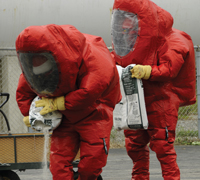
Is Your Team Protected?
Not all certification standards are created equal, not even from the NFPA.
- By Peter A. Kirk, II
- Aug 03, 2009
Hazmat teams at fire departments, industrial companies,
and military units have enough to worry about in hazardous
situations without having to be concerned about
whether their hazmat suits fully protect them. In an effort
to help hazmat professionals ensure their teams are
fully protected, below are answers to some of the most
frequently asked questions about chemical protective suit
standards.
Q: Who sets the standards for certification of hazmat
suits?
A: For more than 100 years, the National Fire Protection
Association (NFPA) has been the leading authority on
fire protection and safety and has developed many of the
standards that hazmat and safety professionals rely on to
keep themselves and their organizations out of harm's way.
However, NFPA standards can be confusing, and industry
knowledge about the importance of purchasing NFPA-certified hazmat suits is sometimes lacking.
Q: What specific NFPA standards are relevant for
hazmat suits?
A: With regard to hazmat suits, the NFPA 1991 standard
(Standard on Vapor-Protective Ensembles for Hazardous
Materials Emergencies, 2005 ed.) defines the highest level
of protection.
Industry professionals also look to the NFPA 1994
standard (Standard on Protective Ensembles for First Responders
to CBRN Terrorism Incidents, 2007 ed.), which is
less stringent than NFPA 1991.
Q: What are some of the requirements for NFPA certification?
A: NFPA certification represents the highest standard in
hazmat suit protection on the market because suits must
pass the organization's rigorous tests of flame, physical,
and chemical resistance to achieve certification.
The flame resistance test consists of a flame source that
touches the outside of a material with a three-second initial
exposure (with no ignition allowed) and a 12-second
subsequent exposure. To meet NFPA 1991 requirements
for adequate protection, for example, the material must
display no burning after 10 seconds, no burning greater
than 4 inches, and no melt or dripping.
The primary chemical test method involves preconditioning
the outside surface of the suit material by abrasion
and flexure followed by chemical exposure. The key point
is to understand that the suit materials are subjected to
damaging conditions prior to chemical exposure.
Specific requirements are different, however, between
the two NFPA standards. Between the highly specific
wording within the NFPA standards and the inconsistency
with which some manufacturers communicate the difference
between them, understanding the right level of certification can be tricky.
Q: What are some of the performance differences between
suits certified to the different standards?
A: Even though many NFPA 1994 Class 2 ensembles visually
resemble those certified to the NFPA 1991 standard,
they don't offer the same level of protection. In general,
NFPA 1994 requirements are looser than NFPA 1991 requirements
for chemical testing, vapor tightness, flame
resistance, and physical properties.
Distinct differences in performance are gas-tight integrity
and flame resistance tests. To meet certification
for NFPA 1991, hazmat suits must maintain at least 3.2
inches H2O during the gas-tight integrity test, and flame
resistance of less than 10-second afterflame with no melt
or drip after 12 seconds. By comparison, NFPA 1994 requirements
for both of these performance characteristics
are not applicable and do not require testing.
Other performance measurements also signal differences
between the two certification levels. The burst strength for the suits under NFPA 1991 is mininum 45 pound force (lbf),
while for NFPA 1994 it is minimum 35 lbf. Similarly, the puncture tear
resistance and seam-breaking strength requirements for NFPA 1991 certification are almost two times greater than NFPA 1994 requirements.
The closure breaking strength is similarly disproportionate for each certification standard as well.
For abrasion preconditioning, NFPA 1991 certification requires 80
grit (coarse) for 25 cycles, while NFPA 1994 requires only 600 grit (very
fine) for 10 cycles.
This is followed by chemical testing, in which the NFPA 1991 standard
requires hazmat suits to withstand 19 different toxic industrial
chemicals, six different gases, and two warfare agents. By contrast, the
NFPA 1994 standard requires suits to withstand three toxic industrial
chemicals, two gases, and two warfare agents. In the 2007 edition of
NFPA 1994, the permeation requirements were loosened. Rather than
measuring for a maximum allowable detection level, the standard now
allows for a cumulative amount of chemical to permeate.
Q: Do all NFPA 1991-certified suits provide the same level of protection?
A: One difference among NFPA 1991-certified suits is flash fire protection,
which only some hazmat suits provide. The flash fire requirement
is optional for NFPA 1991 certification and requires an additional test.
During this test, a suit is positioned inside a propane-filled flash chamber
and must sustain a 6-to-8-second flash fire exposure with an after-flame
of no more than two seconds. After exposure, the suit must maintain airtight
integrity and visual acuity in order to fully meet the requirements.
Additionally, some hazmat suits certified to the NFPA 1991 standard
meet the requirements only when heavy aluminized overcovers are worn.
Basically, they require that a suit be worn over a suit. When using these
dual-layered suits, some hazmat users choose not to wear the over-covers
either, because their purpose is not understood or due to awkwardness
and inconvenience. This leaves them potentially and unknowingly unprotected.
Q: Where can industry professionals go for additional information?
A: We at Saint-Gobain Performance Plastics put together a certification
booklet to help people out, and it's available free of charge on our Web
site. The NFPA also publishes the full text of its
standards on its Web site for a fee.
This article originally appeared in the August 2009 issue of Occupational Health & Safety.